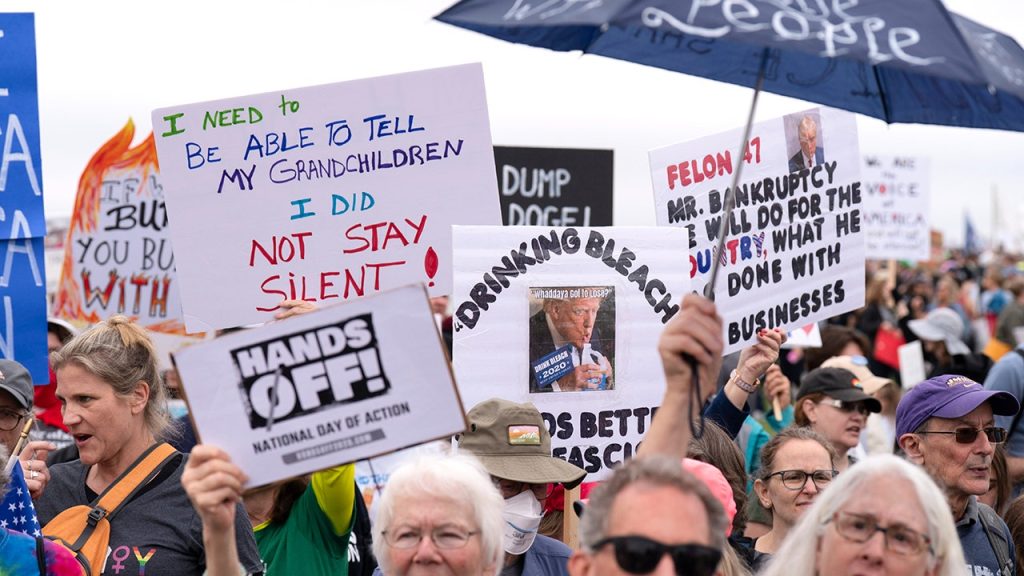In a significant display of political dissent, thousands of protesters occupied the streets across the United States on Saturday to voice their opposition against various policies of the Trump administration. Organized rallies titled “Hands Off!” were held in all 50 states, drawing particular attention to issues such as federal downsizing, reciprocal tariffs, and immigration reforms that have stirred public discontent. While many gatherings remained peaceful, law enforcement maintained a heightened presence to ensure order throughout the day.
| Article Subheadings |
|---|
| 1) Overview of the Nationwide Protests |
| 2) Key Messages from Leaders |
| 3) Public Reactions and Concerns |
| 4) Law Enforcement and Safety Measures |
| 5) A Broader Context of Political Unrest |
Overview of the Nationwide Protests
On Saturday, a series of coordinated protests known as the “Hands Off!” rallies erupted across the United States, drawing significant attention to various contentious policies enacted by the Trump administration. The most notable gatherings occurred at historic sites, including the National Mall in Washington, D.C., and state capitol buildings. Reports indicated that more than 1,200 demonstrations took place nationwide, reflecting a broad spectrum of grievances, from government efficiency and tariff strategies to immigration reform. As protesters took to the streets, their chants and signs articulated a loud demand for policy changes, a sentiment echoed in many cities including New York, Philadelphia, and Cleveland. The term “Hands Off!” served as a rallying cry against perceived government overreach and economic inequality.
Key Messages from Leaders
Prominent figures in the political arena took advantage of the platform provided by the protests to share their perspectives and unify the demonstrators. In Washington D.C., Democratic Representative Jamie Raskin emerged as a central figure, asserting that the rally was a testament to the ongoing pushback against the administration’s policies. In his speech, Raskin declared,
“We are winning every day,”
highlighting recent legal victories against the administration’s actions. He emphasized the importance of defending democratic institutions and denounced the actions perceived as threats to judicial independence. His remarks resonated with many attendees, reinforcing the notion that collective action can yield significant results in the political landscape.
Public Reactions and Concerns
Public sentiment around the protests varied considerably, though many participants shared a common concern regarding the future of social safety nets and economic stability. Among the protestors, numerous signs expressed opposition to policies seen as harmful to essential social programs such as Social Security and Medicare. Moreover, issues stemming from the Israel-Hamas conflict, federal employee layoffs, and the proliferation of diversity, equity, and inclusion (DEI) programs also sparked considerable debate among demonstrators. Activists argued that these issues compounded stress on middle and lower-income families, increasing their grievances against the current administration. As raucous marches and impassioned speeches filled the air, it was evident that protestors were not only advocating for immediate changes but were also seeking a long-term commitment to social equity.
Law Enforcement and Safety Measures
In preparation for the protests, local authorities collaborated with law enforcement agencies to ensure public safety while preserving the right to assembly. Throughout the day, reports indicated that law enforcement officials were present at various demonstration locations, ready to respond to any incidents that could disrupt the peaceful nature of the rallies. The National Park Service commended its personnel for maintaining safety and order, asserting their commitment to supporting the protests while ensuring that First Amendment rights were honored. Many demonstrators acknowledged the police presence but voiced a desire for a respectful approach from law enforcement to prevent situations that could escalate into violence.
A Broader Context of Political Unrest
The recent protests are a part of a larger narrative surrounding political discontent in the United States. As the nation grapples with economic challenges and polarized views on governance, incidents of civil unrest have become increasingly common. The protests against the Trump administration are symptomatic of a broader movement among various demographics who feel marginalized or ignored by current policies. Moreover, the rallies drew attention to the connections between domestic discontent and global pressures, reflecting how political decisions resonate beyond borders. As stakeholders evaluated the implications of these protests, the call for change was evident, signaling a pivotal moment in U.S. political discourse.
| No. | Key Points |
|---|---|
| 1 | Thousands of protesters across the U.S. responded to Trump administration policies. |
| 2 | Rallies were held in all 50 states, with major activities at the National Mall. |
| 3 | Prominent political figures, including Rep. Jamie Raskin, spoke at key gatherings. |
| 4 | Law enforcement ensured safety while allowing peaceful protests to occur. |
| 5 | Wider social issues were highlighted, indicating deep political discontent within the populace. |
Summary
The “Hands Off!” protests signify a crucial moment of democratic expression in the United States, reflecting widespread concerns regarding governmental policies and their implications for social welfare. As demonstrators united across diverse regions, their unified message underscored the potential for collective action to advocate for change. The day’s events illustrated not only the urgency of the issues at hand but also emphasized the resilience of those who demand a more equitable governance model. As the political landscape continues to evolve, these protests may serve to catalyze further discussions regarding public policy and civic engagement.
Frequently Asked Questions
Question: What were the main issues raised in the protests?
The protests focused on a variety of issues, including opposition to federal downsizing, reciprocal tariffs, immigration policies, and the protection of social programs like Social Security and Medicare.
Question: How did law enforcement handle the protests?
Law enforcement was present at key protest locations to ensure safety and maintain order while respecting the demonstrators’ right to assemble peacefully.
Question: What did political leaders say during the protests?
Political leaders, including Rep. Jamie Raskin, emphasized the importance of defending democratic institutions and highlighted recent legal actions taken against the administration’s policies.



